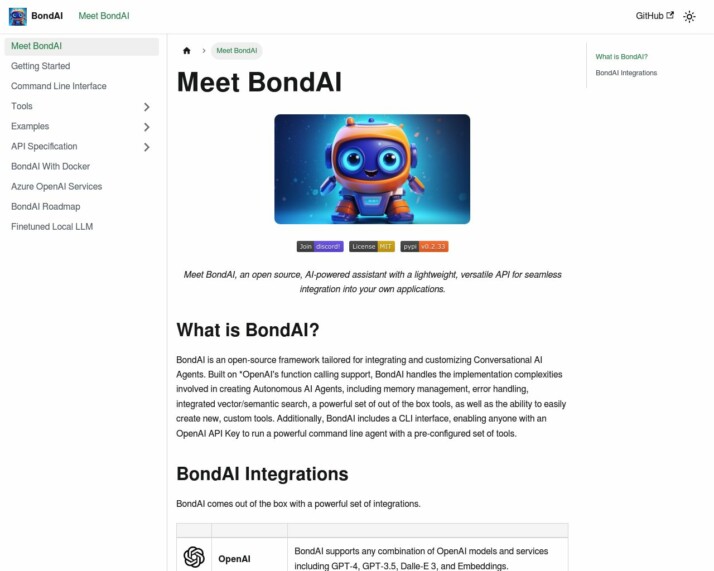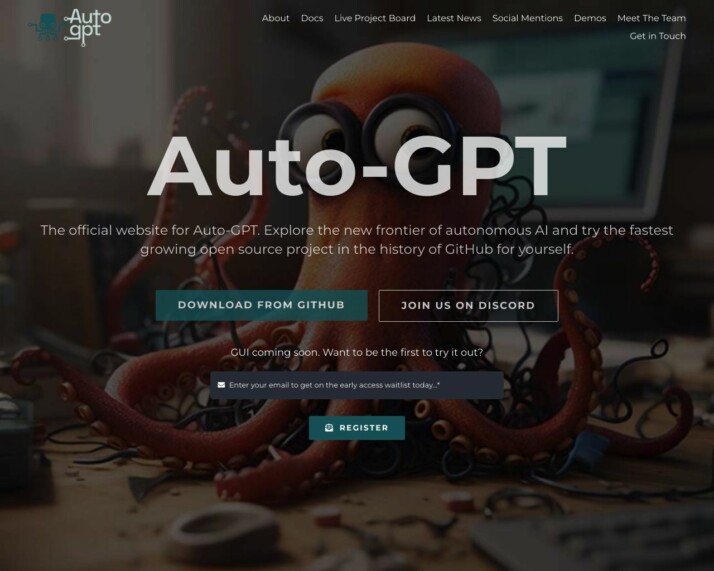Introduction
Are you struggling to choose between BondAI and AutoGPT?
Look no further, as we break down the key features and benefits of these two AI platforms. Whether you’re a developer or a business in need of advanced AI capabilities, this comparison will help you make an informed decision.
In this article, we’ll delve into the unique aspects and functionalities of BondAI and AutoGPT, exploring their integration with cutting-edge AI models, their multimodal capabilities, and their autonomous problem-solving skills.
Additionally, we’ll analyze the target audience each platform caters to and how they meet the specific needs of different user groups.
An Overview of the Exciting New BondAI
Welcome to the BondAI overview. Let’s dive into the basics of what BondAI is all about. BondAI is a versatile platform that focuses on integrating and innovating with Artificial Intelligence (AI). Their mission? To streamline the process for developing AI-driven tools, especially for those who want to create unique conversational AI agents.


BondAI’s offering opens up a world of possibilities for developers, engineers, businesses, innovators, and tech-enabled service providers. Developers and engineers will undoubtedly find BondAI’s comprehensive API and wide array of tools crucial in their AI-centric projects. Businesses and enterprises, on the other hand, can use BondAI to enhance customer interaction and automate processes.
Innovators in Conversational AI can create a plethora of AI applications with BondAI’s easy-to-use platform. Similarly, even service providers in various sectors could use BondAI’s tools to upgrade their services.
One of the most significant BondAI features include its scalability and robust toolset, enabling it to handle the demands of businesses of various sizes. Its recent releases include functionalities for internet searches, market trading, email interactions, and much more.
Despite these varied features, BondAI keeps user-friendly AI interaction at the forefront. BondAI capabilities are tailored for both ease of use and power, fostering innovation and efficiency.
Ultimately, BondAI’s vision is about making AI integration and the development of AI agents more accessible and efficient. They aim for a future where AI-driven applications and services are streamlined, flexible, and scalable. This goal illustrates how BondAI benefits its users by catering to their needs and driving tech innovation.
A Comprehensive Overview of AutoGPT and Its Incredible AI Power
AutoGPT, a notable player in the landscape of artificial intelligence (AI), is targeted primarily at pioneers in AI innovation. This includes, but is not limited to, research institutions, tech startups experimenting with new developments in AI, and enterprises requiring custom AI solutions.


In essence, AutoGPT caters to a userbase that seeks to leverage AI for complex, innovative applications, while also being technically proficient.
AutoGPT’s distinctive, efficient AI offering, known as BabyAGI, is a unique tool that stands out for its autonomous task generation and execution capabilities.
The robustness of BabyAGI can be attributed to its integration with advanced AI technologies including OpenAI’s GPT-4, a state-of-the-art language model, and Pinecone’s vector search engine. Through these advanced technologies, BabyAGI is able to comprehend complex tasks and fetch the most relevant information to complete them.
The vision and objectives behind AutoGPT are centred around creating an AI assistant, BabyAGI, that can function independently and handle a multitude of tasks – both simple and complex. The goal of this autonomous functionality is to reduce the cognitive load on users by taking over routine and complex tasks, thus allowing users to focus on more creative and high-level work.
AutoGPT’s use of cutting-edge GPT models has led to a successful deployment of a sophisticated AI solution that combines the best of both models. This AI solution is capable of handling multiple data types, can autonomously perform complex tasks, and is primarily targeted at environments that require advanced AI capabilities, including language processing and image handling.
In terms of AutoGPT capabilities, an important point to note is the system’s multi-modal functionality, which enhances its versatility and usefulness. The AI’s advanced problem-solving capabilities, impressive autonomous functionality, and the ability to deploy AI agents as APIs are among the exceptional features of AutoGPT. Furthermore, detailed activity logs provided by the system enhance its transparency and aid in troubleshooting and analysis.
In conclusion, AutoGPT offers an advanced and practical AI solution, rich in features and capabilities, aimed at meeting the needs of its technically proficient target audience. It aims to stay at the forefront of AI technology, continuously innovating and evolving in line with its vision and objectives.
Feature Comparison: BondAI vs AutoGPT vs SmythOS
Choosing the right large language model (LLM) for your needs can be challenging. In this in-depth analysis, we compare the essential features of BondAI, AutoGPT, and SmythOS, to assist you in making an informed decision. We focus on aspects that significantly impact performance, functionality, and overall capabilities.
| Features | BondAI | AutoGPT | SmythOS |
|---|---|---|---|
| Hosted Agents (Dev, Production) | ❌ | ❌ | ✅ |
| Environments (Dev, Production) | ✅ | ✅ | ✅ |
| Visual Builder | ❌ | ❌ | ✅ |
| No-Code Editor | ❌ | ❌ | ✅ |
| Memory & Context | ✅ | ✅ | ✅ |
| Explainability and Transparency | ❌ | ❌ | ✅ |
| Autonomous Agents | ✅ | ✅ | ✅ |
| Problem-Solving Capabilities | ✅ | ✅ | ✅ |
| Human-AI Interaction | ✅ | ✅ | ✅ |
| Deploy as GPT | ✅ | ✅ | ✅ |
The aforementioned features play a vital role in navigating your LLM choice. Considering BondAI vs AutoGPT, it’s evident that while both have decent problem-solving capabilities, memory and context, and the ability to deploy as GPT, they both lack in areas such as hosted agents and visual builder.
These features are crucial for less technical users and for providing a smoother and more intuitive user experience.
SmythOS, on the other hand, offers a more comprehensive package, with its generous provision of the essential capabilities that are absent in the others.
Having all these features could mean a more seamless, efficient, and productive experience for the end user. To explore more about the features of each language model, you can visit the BondAI official documentation and AutoGPT website for further reading.
BondAI and AutoGPT: A Detailed Audience Analysis
The BondAI platform primarily caters to a technically adept audience, with a focus on developers and businesses seeking to harness the power of AI for creating sophisticated conversational agents and integrating AI into various applications and services. Its ease of use, scalability, and robust toolset make it appealing to those aiming to innovate or improve efficiency through AI.
The AutoGPT platform targets a technically proficient audience consisting of software developers, tech-savvy businesses, and organizations looking to leverage AI for complex and innovative applications. Its features and applications are designed to address the challenges in software development, project management, and AI-driven automation, making it a valuable tool for these groups.
When comparing the two platforms, BondAI offers a comprehensive framework with a particular emphasis on customization and integration of conversational AI agents. It leverages OpenAI’s function calling support to integrate with various OpenAI models and services, providing a powerful base for creating diverse AI-driven applications.
On the other hand, AutoGPT stands out for its use of advanced GPT models, enabling sophisticated natural language processing and generation capabilities. It also offers autonomous task generation and execution, allowing for a high degree of automation in task management and resolution.
In conclusion, while both BondAI and AutoGPT cater to technically adept audiences, BondAI’s focus on customization and integration of conversational AI agents, combined with its rich toolset and scalability, make it a compelling choice. However, the specific requirements and preferences of each user should be carefully considered when choosing between the two platforms.
Conclusion
After comparing BondAI and AutoGPT, it is evident that both frameworks offer unique features and applications in the field of Conversational AI Agents. BondAI caters primarily to developers and businesses, providing a flexible framework with comprehensive API and a range of tools. It is particularly suited for creating custom AI-driven applications and integrating AI into existing systems.
On the other hand, AutoGPT focuses on leveraging advanced GPT models, offering autonomous functionality and problem-solving skills. It is targeted towards innovators in the AI space, product developers, and enterprises needing custom AI solutions.
When it comes to integration capabilities, BondAI stands out with its support for various OpenAI models and services, including GPT-4 and GPT-3.5. It also offers an integrated vector/semantic search, enabling advanced AI operations.
While AutoGPT utilizes advanced GPT models, its unique aspect lies in its autonomous task generation and execution capabilities. This allows for a high degree of automation and reduces the cognitive load on users.
In conclusion, both BondAI and AutoGPT have their strengths and target different audiences. However, when comparing them to SmythOS, it is clear that SmythOS offers distinct advantages.
With its innovative features, SmythOS provides a versatile and efficient AI agent that prioritizes problem-solving, multimodal capabilities, and autonomous functionality. The integration with top-tier GPT models demonstrates SmythOS’s commitment to staying at the forefront of AI technology.
Last updated:
Disclaimer: The information presented in this article is for general informational purposes only and is provided as is. While we strive to keep the content up-to-date and accurate, we make no representations or warranties of any kind, express or implied, about the completeness, accuracy, reliability, suitability, or availability of the information contained in this article.
Any reliance you place on such information is strictly at your own risk. We reserve the right to make additions, deletions, or modifications to the contents of this article at any time without prior notice.
In no event will we be liable for any loss or damage including without limitation, indirect or consequential loss or damage, or any loss or damage whatsoever arising from loss of data, profits, or any other loss not specified herein arising out of, or in connection with, the use of this article.
Despite our best efforts, this article may contain oversights, errors, or omissions. If you notice any inaccuracies or have concerns about the content, please report them through our content feedback form. Your input helps us maintain the quality and reliability of our information.
Alexander De Ridder
Co-Founder, Visionary, and CTO at SmythOS. Alexander crafts AI tools and solutions for enterprises and the web. He is a smart creative, a builder of amazing things. He loves to study “how” and “why” humans and AI make decisions.
Explore All Comparison Articles
Decisions vs. Sola: AI Workflow Automation Showdown
AI-powered workflow automation platforms revolutionize how businesses streamline operations and boost productivity. This comparison explores Decisions vs. Sola, and SmythOS,…
DeepOpinion vs. Sola: Comparing AI Automation Platforms
AI-powered automation platforms revolutionize business operations, but choosing the right solution can be challenging. This comparison of DeepOpinion vs. Sola,…
DevGPT vs. Sola: AI-Powered Development Tools Compared
AI-powered development tools revolutionize software creation, offering unprecedented efficiency and capabilities. This comprehensive review compares DevGPT vs. Sola, and SmythOS,…
Fine AI vs. Sola: Comparing AI Automation Tools
AI-powered automation transforms software development and business workflows, offering unprecedented efficiency and innovation. Fine AI vs. Sola present distinct approaches…
FlowiseAI vs. Sola: Comparing AI Automation Platforms
AI-powered automation revolutionizes business operations, driving efficiency and innovation across industries. FlowiseAI vs. Sola offer distinct approaches to harness this…
Gooey AI vs. Sola: AI-Powered Automation Platforms Compared
AI-powered automation platforms revolutionize how businesses streamline operations and enhance productivity. This comparison delves into Gooey AI vs. Sola, two…

